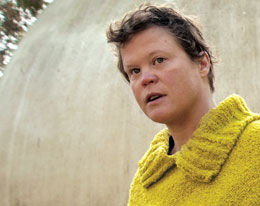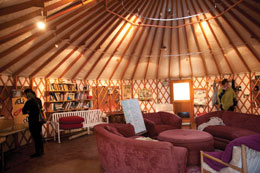Volume 29 · Number 3 · Spring 2012
There's no place like dome
Just when it looked like the end for Baggins End, the student housing co-op gets a new lease on life.

The Domes community consists of 14 polyurethane-insulated fiberglass domes like this one.
(Gregory Urquiaga/UC Davis)
Students have moved back into the "Domes," a funky 1970s experiment in communal living and one of the few student-built housing cooperatives in the nation.
The Domes community is getting an upgrade and a new vision for its future. Several of the 14 Domes — officially known as Baggins End Innovative Housing at UC Davis — are now occupied, thanks to a five-year lease that the university signed in December with a Davis-based, nonprofit group called the Solar Community Housing Association to manage the neighborhood.
Student residents applaud the turnaround. Last spring, the almost 40-year-old Domes seemed doomed by needed, costly repairs, and the university asked the residents to leave. Then the dialogue intensified on what the Domes really mean to the community and to UC Davis.
"It's an extraordinary place that offers experiential learning opportunities for people," said JayLee Tuil '99, M.A. '08, a doctoral student in geography and Domes resident.
The hope, Tuil explained, is that Domes becomes part of the UC Davis academic mainstream. The long-range plan is to "transition to the academic community" and integrate the community with departments like landscape architecture, environmental design and civil engineering.
"It's all unknown at this point," Tuil acknowledged. "But we've got five years and a good start to figuring it all out."
Built on the western edge of campus, Baggins End — the name comes from Bag End, the home of Bilbo Baggins, the lead character in J.R.R. Tolkien's fantasy novel The Hobbit — has been the subject of research, tours and courses through the years. There are organic gardens, chickens, permaculture, composting beds, fruit trees, solar energy technology, a tool shed and all the building blocks of sustainability — a key academic strength at UC Davis.
To many, the Domes represent a real-world demonstration of how to achieve eco-friendly living, the kind studied in campus labs and classrooms.
Sustainability, Tuil said, often comes down to being an engaged neighbor: "Living here, you learn how to effectively communicate in ways you may not be accustomed to in order to live and solve problems with your neighbors." And that — learning how to collaborate and communicate — is yet another educational opportunity that the Domes have to offer.
One of the new Dome residents is Sheryl Sensenig, who is studying agricultural and environmental education.
"It's exciting to have a small part in the large community effort to save the Domes and see them re-inhabited," Sensenig said.
It almost never happened.
Community volunteers
In the beginning, the Domes were not meant to last forever — only five years, in fact. Each 450-foot-square dome is constructed of three to four inches of polyurethane foam covered by a fiberglass shell that serves to protect inhabitants from outside elements. The white exterior and thick insulation keeps them cool in the summer and warm in the winter — just like boat hulls made of the same material. Typically, one or two students share each unit.
But concerns arose last year with a report of degradation of the foam structure within the Domes. University officials and independent inspectors identified numerous structural, health and safety, and fire code issues along with the need for improvements required by the Americans with Disabilities Act.
The campus had announced in February 2011 that it would not re-offer a lease when agreements expired at the end of July 2011. The prefabricated fiberglass-and-foam huts would be too costly to fix, officials maintained.
Domes residents and alums worried that four decades of experience in communal living would be lost. So they pressed the university to explore solutions, and received an outpouring of support from the community.
After the university reached an agreement with the Solar Community Housing Association to serve as a third-party management group, UC Davis officials gave the group the green light to make repairs and lease the units back to students. The Domes cooperative, which housed a total of 28 students last year, had been vacant since early August 2011.

JayLee Tuil, '99, M.A. '08
(Gregory Urquiaga/UC Davis)
At a weekend work party last November, about 450 volunteers completed roughly 90 percent of the necessary repairs, from painting to installing new ventilation. Local artists created tile mosaics and large-scale murals, and local businesses and restaurants donated materials and food. Funds were donated by other nonprofits, notably the Berkeley Student Cooperative.
"It was overwhelming," Tuil said of the volunteer effort. "It's a testament to the spirit of the place."
One bright new feature is that the Domes will provide full accessibility for the disabled. These modifications are expected to be complete by the end of summer — just in time to celebrate the community's 40th anniversary.
'The moon with gum drops'
Former Dome resident Cat Callaway '10 said living at the Domes opened her mind to the world — and the people — around her.
Dome, sweet dome
The igloo-shaped Domes opened in the fall of 1972 as an experiment that some thought might last just a few years. Students seeking less expensive housing options on campus made a few different proposals, and the dome style was chosen. It looked cool and certainly different.
"You see things differently," said Callaway, who studied agricultural management and rangeland resources. "You think about your neighbors, and they think about you. You think about your environment and how to live in it. It makes you more sensitive."
Openness and communication are critical skills to develop, Callaway said. The residents hold meetings where they make decisions by consensus, and workshops are held on topics like nonviolent communication and mediation.
"How things affect the community is what we talk about. Conflict arises, as in any human group," Callaway noted. "But we strive to work it out."
The Domes themselves are not without personality, either. They were not always white — back in the day, Callaway said, many were painted or accented with bright colors.
"They looked like the moon with gum drops," she said.
Learning opportunities
Standing tall on the grounds is the yurt, which was erected in spring 2008. The wood-framed dwelling structure traditionally used by Turkic nomads in the steppes of Central Asia is a gathering place where most of the community meals and meetings take place. On the walls that surround the large, comfy sofas in the center are photos, bulletin boards, news clippings and plenty of community creed: "Friendship. Culture. Community. Gardens. Sustainability. Nourishment."

The community also features a "yurt," a wood-framed dwelling where the many resident meetings and events are held. (Gregory Urquiaga/UC Davis)
One might add "connection" — that's what the future is about, connecting the Domes to the academic mission of the campus.
One person who's making that possible is Mary Hayakawa, executive director of UC Davis real estate services. She led the university's efforts to negotiate with the association for the ground lease and a license that allowed repair work to begin in advance of the lease signing.
Hayakawa was impressed by the volunteer repair efforts. "The Domes experience proves that when people work together with a positive outlook and the energy and enthusiasm of youth, they can achieve anything."
The students who moved in are eager to expand the legacy of the Domes. Monthly rent is $395 per student, not a bad deal for a huge slice of community.
Greta Lelea '00, M.A. '05, Ph.D. '09, is a member of the Solar Community Housing Association's board of directors as well as a UC Davis postdoctoral researcher and a former Domes resident.
"The re-opening of the Domes demonstrates how community support and participation, open dialogue and collaboration can make large projects happen, even in a time of austerity," she said.
She added, "This is bigger than just housing. It is about how to live in a more sustainable and cooperative world."
Indeed, a team of five students from Oberlin College in Ohio will work on sustainability projects during a month-long internship at UC Davis. The Domes will be part of their project.
"The story of the Domes is very compelling to members of other student co-ops," said Isabel Call, M.S. '11, a former resident of the Domes who earned her bachelor's degree from Oberlin College.
There was even an engineering class this past winter quarter — "Planning of Green Civil Systems" — focused on designing the new structures at Baggins End. That blends in well with the long-term future envisioned by Tuil and others.
But it is not all about education and innovation. Beyond the classroom, beyond all the challenges and doubts of the last year, the community simply has a special place deep in Tuil's heart.
"Living here was part of my healing process," said the graduate student, who was hurt in a severe trolley accident in 2007.
During her long recovery — and it was not an easy one — she lived in one of the Domes. She found the place and the people inspiring, nurturing and supportive.
"I was changed by this place in ways I'll never forget," said Tuil, a tear on her cheek.
